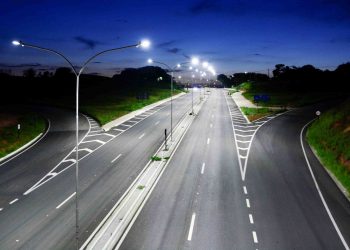
Lighting Design for Supermarkets: Know Its Importance for the Best Results
Lighting design for supermarkets should be treated with special attention. In all sectors of commerce and industry, this point is extremely important to ensure productivity and safety, reduce accidents, and improve environmental comfort.
However, in supermarkets, lighting takes on an even greater role because it is an essential part of the customer experience (CX). Nowadays, marketing and sales research shows that CX is one of the main factors in attracting and retaining customers.
But what does this mean? Companies must offer an impeccable shopping journey, going far beyond aspects related to price and service. In this sense, sensory stimuli are extremely important because they generate valuable positive emotions for the individual’s evaluation of the experience.
Want to better understand all these benefits? Follow along!
What is a lighting design project for supermarkets?
As we will see below, in many businesses, lighting is decisive for the success of corporate strategies. Therefore, it should not be conducted in an amateur or unprofessional manner. The ideal is to have a specific planning process conducted and executed by service providers and suppliers with extensive experience in industrial and commercial lighting.
The lighting design project allows your company to plan the lighting strategy at different levels:
- Strategic – is the entire process that allows you to perceive the gains that lighting can bring to your corporate goals and establish what your objectives are with the specific project;
- Tactical – allows the establishment of guidelines and actions to ensure the success of your goals. Thus, it involves the choice of materials, parts, and suppliers of excellence;
- Operational – the project also guarantees correct electrical sizing, compliance with technical standards from ABNT and ISO, compensation for reflections and shadows, among other points.
With this, lighting ceases to be just another structural detail and becomes a commercial strategy.
What are the advantages of a good lighting design project for supermarkets?
Loss prevention
Supermarkets are one of the preferred targets of theft and robbery. Several studies show their influence on reducing crime. After all, it facilitates the identification of malicious actions by employees and ensures the capture of sharper images by security cameras. Consequently, thieves will look for less illuminated stores to act.
In addition, in supermarkets, losses are also related to the expiration or deterioration of products. Good lighting allows the identification of products outside the appropriate conservation location, the visualization of problems in packaging, and the expiration date, among others.
Thermal efficiency
Supermarkets deal with perishable and extremely heat-sensitive products. So, internal thermal control must be very precise to ensure that shelves, freezers, and refrigerators are at the ideal temperature.
Some lamp models, such as incandescent and fluorescent lamps, generate a lot of heat. Thus, they can harm thermal stability, increasing the need for artificial air conditioning.
On the other hand, LEDs have advanced technology for maximum use of power with minimal heating.
Energy efficiency and cost reduction
On the lighting equipment packaging, there is information about its power, luminous flux, and efficiency.
Many people think that the higher the power, the better a device illuminates. This relationship is incorrect because power indicates the amount of energy that device can consume over time. Measured in watts, the higher it is, the higher the energy cost.
It is the luminous flux that indicates the amount of light that that piece emits in its beam. It is measured in lumens. The higher it is, the greater the capacity of a light to illuminate the environment. Therefore, you should choose items that have a better luminous flux for each unit of power. See the comparison of technologies to produce the same amount of light (800 lumens):
- An incandescent lamp requires 60 watts of power. The luminous efficiency is 13.3 lm / w;
- Fluorescent lamps already spend 15 watts. Luminous efficiency is 53.3 lm / w; LED luminaires use an average of 9 watts, and efficiency is 88 lm / w.
This means that LED lighting reduces energy consumption by around 6 to 8 times (compared to incandescent bulbs) and by 2 times (compared to fluorescent bulbs). Why is LED so much more efficient? It loses less energy in the form of heat. Thus, in addition to spending less on lighting, one can save on air conditioning and cooling.
Sustainability
A large part of the energy consumed comes from sources that cause some level of harm to the environment. When you consume less, you are contributing to the sustainability of the planet. In addition, unlike fluorescent and incandescent bulbs, all materials in LEDs are recyclable and do not contain toxic substances.
What is the influence of supermarket lighting on the customer experience?
A large part of the customer experience in supermarkets is related to physical sensations. In this area of physical retail, people want to see, touch, smell, taste, and hear the products:
- The colors and design of the labels attract interest;
- Then, they will read the package label carefully in search of information that helps them understand how that item will solve their problem;
- To confirm their impression, they may shake the box to hear the sounds of the content, bring the product closer to their nose, look for tastings, among other actions; Thus, they decide whether or not to put the product in the cart.
The shopping journey, therefore, should always be designed so that sensory stimuli create an impeccable impression from the moment they see the facade of the establishment until after payment at the checkout.
In any case, vision is the first point of contact and will define the entire experience. Studies show that in marketing and sales, the first impression is really what counts. But how does good supermarket lighting design influence this? Understand:
More attractive façade – Choosing good reflectors allows for highlighting the most important details of your brand. In addition, it avoids negative stimuli that drive customers away, such as the feeling of insecurity in poorly lit areas.
Guiding the customer journey – With lighting strategies, you can guide the customer towards the products and priority sections for your business.
Display of packaging – The lighting should allow for sharpness and preservation of the original colors, which are designed to optimize the product’s attractiveness.
Reading labels and tags – Difficulty in reading information due to low lighting causes the customer to lose interest in the product.
Prevention of negative stimuli – Visual discomfort caused by lack or excess of lighting triggers bodily reactions of concern or anxiety, disrupting the shopping experience. Thus, the customer may give up on the entire purchase or reevaluate the need for items they placed in the cart.
Therefore, consider supermarket lighting as part of your commercial strategy. A good supermarket lighting project with lighting design allows for several advantages. For this reason, seek the assistance of a team with expertise for proper planning and execution, purchase from excellent suppliers, and choose the most advanced technologies such as LED.
If you already know the importance of having a lighting project for supermarkets and want to talk to our experts right now, contact us!
Share







